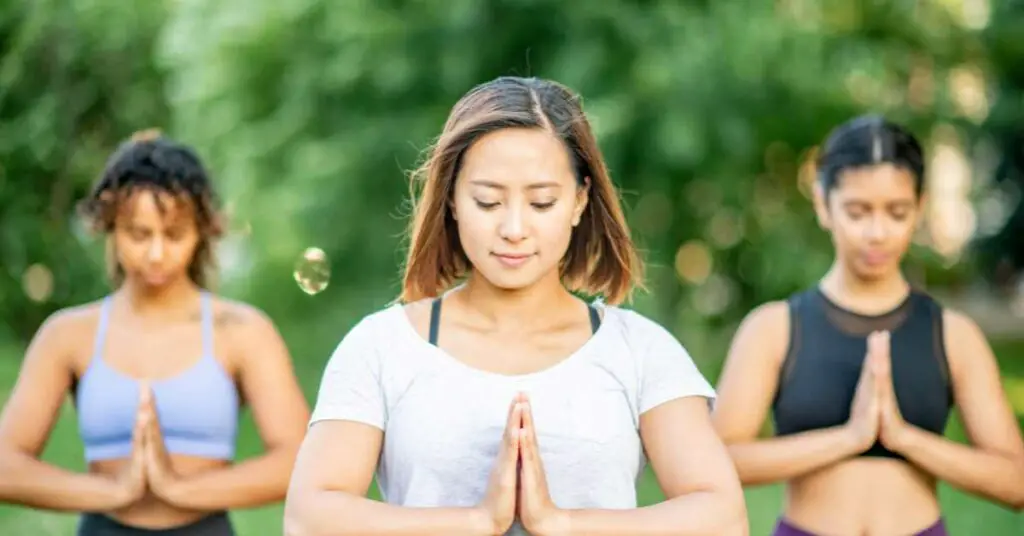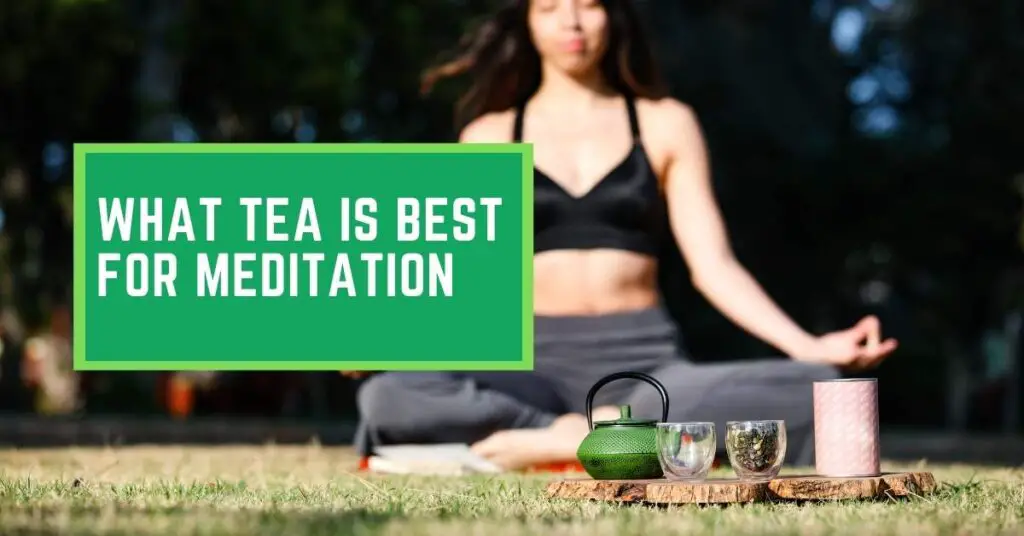In today’s fast-paced and demanding world, finding moments of peace and tranquility has become increasingly essential for our well-being. Meditation, a practice that has been embraced for centuries, offers a pathway to inner calm, improved focus, and a greater sense of self-awareness.
With its multitude of benefits, meditation has gained widespread popularity, attracting people from all walks of life.
You can meditate standing up. Standing meditation is a valid and practiced form of meditation that offers unique benefits and experiences. It allows you to cultivate mindfulness, body awareness, and grounding while maintaining an upright posture.
While seated meditation is the most well-known and widely practiced form, there are various meditation techniques that cater to different preferences and circumstances.
One such technique is standing meditation, which brings a unique perspective to the practice. In this article, we will delve into the realm of standing meditation, exploring its benefits, techniques, and how it can be incorporated into your daily routine.
Join us as we embark on this journey of discovery, uncovering the nuances and advantages of standing meditation.
From exploring its origins and dispelling common misconceptions to understanding the mind-body connection and incorporating breathwork, movement, and visualization techniques, we will provide a comprehensive guide to help you embrace the practice of standing meditation.
Whether you are new to meditation or a seasoned practitioner looking to expand your repertoire, this article will equip you with the knowledge and tools to embark on a fulfilling standing meditation practice.
So, let us begin our exploration of this transformative practice, and together, discover the profound benefits and serenity that standing meditation has to offer.

What is Meditation?
Meditation is a powerful practice that offers a multitude of benefits for our physical, mental, and emotional well-being.
Let’s explore the different dimensions of meditation and its profound impact on our lives.
Promoting relaxation and stress reduction
Meditation provides a sanctuary of calm in the midst of the chaos of daily life. By engaging in meditation, we can quiet the incessant chatter of our minds and tap into a state of deep relaxation.
Numerous studies have shown that meditation techniques, such as focused breathing or mindfulness meditation, can effectively reduce stress levels and promote a sense of inner peace. Physiologically, meditation has been found to lower blood pressure, decrease heart rate, and alleviate symptoms of anxiety and depression.
Cultivating mindfulness and self-awareness
One of the core aspects of meditation is the cultivation of mindfulness, which involves bringing our attention to the present moment without judgment. Through regular practice, meditation enhances our ability to be fully present and aware of our thoughts, emotions, and bodily sensations.
This heightened self-awareness allows us to develop a deeper understanding of ourselves, our patterns of thinking, and our emotional responses.
Mindfulness meditation has also been associated with personal growth, as it encourages us to explore our inner landscape, cultivate self-compassion, and develop a more authentic connection with ourselves and others.
Spiritual and philosophical dimensions
While meditation has gained popularity as a secular practice, it has deep roots in spiritual traditions. Various religious and philosophical systems, such as Buddhism, Hinduism, and Taoism, incorporate meditation as a means of spiritual exploration and self-realization.
Meditation provides a pathway to connect with the transcendent aspects of our existence, inviting us to delve into profound questions about the nature of reality, the self, and our place in the world.
It offers a space for introspection, contemplation, and the exploration of philosophical principles such as impermanence, interconnectedness, and non-attachment.
In summary, meditation encompasses a range of techniques and approaches that promote relaxation, stress reduction, mindfulness, self-awareness, and spiritual growth. Whether pursued for its physical, psychological, or philosophical benefits, meditation offers a transformative journey of self-discovery and inner peace.
So, take a deep breath, find a comfortable posture, and let us embark on this profound exploration of meditation’s wonders.
Different Types of Meditation Techniques
Meditation is a vast and diverse realm with various techniques tailored to different preferences and needs.
In this section, we will explore some unique aspects of standing meditation, as well as the incorporation of guided imagery, visualization, and dynamic movement.
Introduction to standing meditation
Standing meditation is a practice that involves maintaining an upright posture while cultivating a state of meditative awareness. It has roots in various cultural and spiritual traditions, including Taoist and martial arts practices.
The standing posture in meditation provides a sense of stability and grounding, allowing practitioners to connect deeply with their body, breath, and surroundings. Posture and alignment play a crucial role in standing meditation, as they facilitate the flow of energy and enhance the overall experience.
Unlike seated meditation, standing meditation offers versatility in terms of practicing it indoors or outdoors, making it accessible for those who find sitting for long periods uncomfortable.
Guided imagery and visualization
Guided imagery and visualization techniques can be seamlessly incorporated into standing meditation, enhancing the depth and focus of the practice. Visualization involves creating vivid mental images of specific objects, scenes, or experiences.
During standing meditation, visualizations can be used to evoke a sense of calm, clarity, or to cultivate specific qualities such as compassion or gratitude.
Visualizations can also be used to explore inner landscapes, symbolize intentions, or facilitate healing processes. By engaging the power of imagination and visualization, practitioners can deepen their connection with the present moment and explore the realms beyond the physical body. To encourage visualization in standing meditation, one can visualize elements of nature, envision energy flow through the body, or imagine being rooted like a tree.
Dynamic movement in standing meditation
Incorporating gentle movement or qigong exercises into standing meditation adds a dynamic element to the practice, enriching the overall experience. Qigong, a traditional Chinese practice, combines movement, breathwork, and meditation to cultivate and balance energy.
In standing meditation, gentle movements can be integrated to enhance body awareness, promote relaxation, and improve the flow of vital energy (Qi). Simple movements such as gentle swaying, stretching, or rotating the limbs can help release tension, increase circulation, and deepen the mind-body connection.
By combining movement with mindful presence, practitioners can experience a harmonious integration of body and mind, fostering a greater sense of vitality and mindfulness.
By exploring the various dimensions of standing meditation, incorporating visualization, and integrating gentle movements, individuals can customize their meditation practice to suit their needs and preferences.
Standing meditation offers a unique opportunity to find stillness while remaining in an upright posture, allowing practitioners to cultivate balance, stability, and a deep connection with their bodies and surroundings.
So, let us explore these techniques and embark on a journey of discovery and transformation through the practice of standing meditation.

Can You Meditate Standing Up?
In the realm of meditation, there is often a misconception that the practice necessitates a seated position. However, the truth is that meditation can be effectively practiced in various postures, including standing.
In this section, we will address common misconceptions, explore the historical and cultural contexts of standing meditation, and discuss the benefits of this unique practice.
Debunking common misconceptions
It is important to address the prevailing misconception that meditation can only be practiced while sitting. While seated meditation is widely known and practiced, standing meditation has a rich history and is deeply rooted in various cultural and spiritual traditions.
Standing meditation has been embraced in practices such as Qigong, Tai Chi, and Zen Buddhism. By debunking this misconception, we open ourselves up to the myriad possibilities that meditation offers in terms of posture and experience.
Historical and cultural contexts of standing meditation practices
Standing meditation has been practiced for centuries, originating from diverse cultural and spiritual traditions. For instance, in Chinese martial arts, standing meditation is used to develop internal strength, cultivate energy flow, and enhance body awareness.
In Zen Buddhism, practitioners engage in Zhan Zhuang, a standing meditation practice, to develop stillness, concentration, and insight. Understanding the historical and cultural contexts of standing meditation can shed light on its profound significance and effectiveness as a meditation posture.
The flexibility of meditation practices to accommodate different postures
Meditation is a versatile practice that can be adapted to suit individual needs and preferences. It is not limited to a particular posture. Seated meditation is often recommended due to its stability and ease of maintaining focus.
However, standing meditation offers unique advantages and can be a valuable addition to one’s meditation practice. The flexibility of meditation practices allows practitioners to explore various postures, including standing, and discover what works best for them.
Personal preferences and suitability
When it comes to choosing a meditation posture, personal preferences and individual needs play a significant role.
It is essential to encourage readers to experiment with different meditation postures, including standing, and explore what resonates with them on a physical, mental, and emotional level. Factors such as physical abilities, comfort, and cultural background can influence one’s suitability for different postures.
Providing guidance on finding the most suitable meditation posture based on personal needs and preferences allows individuals to personalize their practice and maximize its benefits.
By dispelling misconceptions, acknowledging the historical context, and embracing the benefits and individual preferences, we can fully appreciate and integrate standing meditation into our meditation journey.
So, let us open ourselves to the possibility of finding stillness and tranquility in an upright posture, allowing our practice to evolve and thrive.
Which Situations Encourage Standing Meditation?
Meditation is not limited to specific settings or isolated moments of solitude. Standing meditation can be incorporated into various situations and environments, enhancing our mindfulness and connection to the present moment.
In this section, we will explore the situations that encourage standing meditation and the unique benefits they offer.
Incorporating meditation into daily activities
Standing meditation provides an opportunity to infuse mindfulness into our everyday routines.
There are numerous situations throughout the day where standing meditation can be seamlessly integrated.
For example, while waiting in line at the grocery store, instead of feeling impatient or distracted, we can use that time to stand mindfully, focusing on our breath, body sensations, and the present moment.
Similarly, during daily commutes, standing on a bus or train can be transformed into a moment of centered awareness.
Even while performing light tasks such as washing dishes or folding laundry, we can engage in standing meditation, bringing mindfulness to our movements and fully immersing ourselves in the present experience.
By recognizing these moments, we can turn ordinary activities into opportunities for standing meditation and cultivate a greater sense of presence in our daily lives.
Connecting with nature through standing meditation
Practicing standing meditation outdoors amplifies our connection with nature and enriches the meditative experience.
Natural environments have a soothing effect on our senses, allowing us to tap into a deeper level of awareness. Standing in a park, garden, or by body of water, we can immerse ourselves in the sights, sounds, and sensations of nature.
The gentle rustling of leaves, the warmth of sunlight on our skin, or the soothing sound of flowing water become focal points for our attention during standing meditation.
By connecting with the natural world, we can enhance our mindfulness and experience a profound sense of peace and interconnectedness.
Group and community settings
While meditation is often seen as an individual practice, standing meditation can also be practiced in group settings, amplifying its benefits through collective energy and support.
Group standing meditation sessions create a unique atmosphere of shared intention and unity. The collective stillness and focused presence in the group setting can deepen our individual practice.
Participating in group standing meditation offers an opportunity for shared growth, encouragement, and accountability. It allows us to tap into a collective energy field that can amplify our individual experiences and inspire a sense of connectedness.
For those interested in exploring group standing meditation, joining meditation groups, workshops, or retreats can provide guidance, camaraderie, and a supportive environment to enhance their practice.
By recognizing the potential for standing meditation in our daily activities, connecting with nature through outdoor practice, and exploring group settings, we expand the possibilities of our meditation practice.
Standing meditation invites us to be fully present in various contexts, infusing mindfulness into our everyday lives, deepening our connection with nature, and fostering a sense of community. So, let us embrace these situations that encourage standing meditation and discover the transformative power they hold.

What are the Benefits of Standing Meditation?
Standing meditation offers a range of benefits for our physical, mental, and spiritual well-being.
In this section, we will explore the advantages of standing meditation and how it positively impacts various aspects of our lives.
Physical benefits
One of the notable benefits of standing meditation is its positive impact on our physical health. By practicing standing meditation regularly, we can improve our posture, balance, and body awareness.
Standing with a straight spine and proper alignment strengthens the core muscles, supports the natural curvature of the spine, and reduces strain on the back. Over time, this can alleviate common postural issues and contribute to a more upright and balanced posture in daily life.
Additionally, standing meditation engages the muscles of the legs, promoting strength and stability. It can also enhance flexibility and joint mobility, increasing our overall physical vitality and well-being.
Mental and emotional benefits
Standing meditation provides a host of mental and emotional benefits that support our overall well-being. The practice cultivates mental clarity and focus by training our attention to remain anchored in the present moment.
Regular standing meditation can enhance cognitive function, improving our ability to concentrate, make decisions, and solve problems. Moreover, standing meditation offers a space for stress reduction and emotional resilience.
By grounding ourselves in the present moment, we can develop a greater sense of inner calm and the ability to respond to stressors with equanimity. Studies have shown that standing meditation can positively impact mood, reduce symptoms of anxiety and depression, and enhance emotional self-regulation.
It can also foster creativity, inspiring new perspectives and insights.
Spiritual and transcendent experiences
Standing meditation holds the potential for transcendent states and spiritual insights. By practicing standing meditation, we can deepen our spiritual awareness and connection to the transcendent aspects of life.
Standing in a grounded and upright posture, we open ourselves to a profound sense of presence and interconnectedness. This can lead to experiences of unity, expanded consciousness, and a deeper understanding of ourselves and the world around us.
Standing meditation has been valued in spiritual traditions for its ability to facilitate self-realization, inner transformation, and a heightened sense of spirituality.
Anecdotal accounts and spiritual traditions provide rich insights into the transformative potential of standing meditation. Many individuals have reported experiencing profound moments of clarity, interconnectedness, and a deepening of their spiritual practice through standing meditation.
It is worth noting that the spiritual dimensions of standing meditation can vary across traditions and personal beliefs. It is a practice that invites us to explore our own spiritual journey and connect with our inner wisdom.
In summary, standing meditation offers a wide range of benefits. It improves posture, balance, and body awareness, contributing to better physical health. Mentally and emotionally, it enhances clarity, focus, stress reduction, and emotional well-being.
Standing meditation also opens the door to spiritual experiences and deeper connections with the transcendent. By embracing this practice, we can embark on a holistic journey of self-discovery, physical vitality, and spiritual growth.
Common Misconceptions about Standing Meditation
Standing meditation, although a valuable and versatile practice, is often subject to misconceptions. In this section, we will address some of the common misunderstandings and shed light on the true nature and benefits of standing meditation
Meditation requiring a seated posture only
- One common misconception is that meditation can only be practiced in a seated position. While seated meditation is widely known and practiced, it is important to recognize that different meditation postures offer unique benefits and serve specific purposes.
Standing meditation, for instance, allows practitioners to engage their entire body, fostering a deeper mind-body connection. By standing, we can cultivate a sense of stability, grounding, and an active presence that can enrich our meditation practice.
It is essential to encourage readers to explore and experiment with different meditation postures, including standing, to discover what resonates with them and supports their meditation journey.
Lack of focus and relaxation in standing meditation
- Another misconception is that standing meditation is more challenging for achieving focus and relaxation compared to sitting meditation.
However, standing meditation can be just as effective in promoting focus and relaxation when approached with the right techniques and mindset.
By grounding ourselves in an upright posture, we can cultivate a sense of stability and centeredness. Standing meditation allows us to bring awareness to our body and breath, helping to anchor our attention in the present moment. Techniques such as mindful breathing, body scan, or visualization can be incorporated to deepen relaxation and promote focus in standing meditation.
Anecdotal experiences and scientific research have shown that standing meditation can be a powerful tool for achieving states of relaxation, clarity, and heightened awareness.
Limited accessibility and suitability
- There is a misconception that standing meditation is only suitable for certain individuals or body types. However, standing meditation is adaptable and can be modified to accommodate different physical abilities and conditions.
Various standing postures can be adjusted to meet individual needs, ensuring comfort and safety during practice. For those with physical limitations, modifications such as using a chair or wall for support can be implemented.
It is important to encourage inclusivity and emphasize that meditation is a personal journey that can be tailored to individual preferences and capabilities. By exploring different meditation postures, individuals can find the approach that best supports their well-being and allows them to reap the benefits of standing meditation.
By addressing these misconceptions, we can expand our understanding of standing meditation and its accessibility to a wider audience. Standing meditation offers a unique opportunity to integrate mindfulness and movement, fostering a deeper mind-body connection.
It encourages us to explore different postures, adapt the practice to our needs, and find a sense of grounding and stability. So, let us dispel these misconceptions and embrace the transformative potential of standing meditation in our meditation journey.
Incorporating Standing Meditation into Your Daily Routine
Standing meditation can be a powerful practice when integrated into your daily routine.
In this section, we will explore how to find the right time and space for your practice, establish consistency, and adapt standing meditation to busy schedules.
Finding the right time and space
Setting aside dedicated time and creating a conducive environment for standing meditation is essential for focused and meaningful practice. Consider identifying suitable times in your day when you can carve out a few minutes for meditation.
It could be in the morning to start your day with presence, during a break from work or studies to refresh your mind, or in the evening as a way to wind down. Find a quiet space where you can stand comfortably without distractions. Create a soothing ambiance by dimming lights, playing calming music, or using essential oils.
By intentionally designating a time and space for standing meditation, you set the stage for a more immersive and fulfilling experience.
Establishing a consistent practice
Consistency is key to reaping the full benefits of standing meditation. Establishing a regular routine helps integrate the practice into your daily life. Start by committing to a specific time and duration for your standing meditation sessions.
It can be as little as five minutes a day, gradually increasing the duration as you progress. Consider setting reminders or alarms to ensure you honor your practice. Be patient and gentle with yourself as you build consistency.
Even on days when motivation wanes, remind yourself of the positive impact standing meditation has on your overall well-being. Surround yourself with supportive resources such as meditation apps, guided meditations, or a meditation journal to enhance your commitment and deepen your practice.
Adapting standing meditation to busy schedules
In the midst of busy schedules, it can be challenging to find extended periods for standing meditation. However, even brief moments of practice can make a difference. Explore time-efficient variations and modifications of standing meditation that fit into your schedule.
For example, you can integrate micro-meditations by taking mindful standing breaks throughout the day. Pause for a minute or two during transitions or while waiting for an appointment. Embrace the opportunity to find stillness and connect with your breath in those brief moments.
Prioritize self-care by recognizing the value of standing meditation in your overall well-being. Make it a non-negotiable part of your routine, just like eating or sleeping, and create boundaries to protect your meditation time.
By finding the right time and space, establishing a consistent practice, and adapting standing meditation to busy schedules, you can seamlessly incorporate this transformative practice into your daily routine. Embrace the flexibility and accessibility of standing meditation, allowing it to become a nourishing and uplifting part of your life.
So, prioritize self-care, commit to your practice, and embark on a journey of inner stillness and self-discovery through standing meditation.
Other Meditation Postures
While standing meditation offers unique benefits, there are several other meditation postures that you can explore and incorporate into your practice. Each posture provides a different experience and may resonate differently with individuals. In this section, we will explore some of the commonly practiced meditation postures.
Seated Meditation
Seated meditation is the most well-known and widely practiced meditation posture. It offers stability, and comfort, and allows for extended periods of meditation. The most common seated postures include:
- Cross-legged (Lotus or Half-Lotus): This traditional posture involves crossing the legs and placing the feet on the opposite thighs.
- Burmese: In this posture, the legs are crossed with both feet resting on the floor.
- Seiza: Seiza involves kneeling with a cushion or meditation bench to support the body.
Seated meditation allows the spine to be aligned, promoting an upright posture conducive to deepening concentration and mindfulness.
Supine Meditation
Supine meditation involves lying flat on your back, with your arms comfortably resting by your sides. This posture promotes deep relaxation and is particularly suitable for body scanning and guided relaxation meditations.
It can be practiced on a yoga mat or a comfortable surface.
Walking Meditation
Walking meditation is a dynamic practice that involves walking slowly and mindfully. It can be done indoors or outdoors in a peaceful environment.
The focus is on the sensation of each step, the breath, and the present moment. Walking meditation allows for the integration of mindfulness into daily movements, providing an opportunity to cultivate awareness and serenity while in motion.
Kneeling Meditation
Kneeling meditation involves sitting on heels with the knees touching the ground or using a cushion for support.
This posture can help create stability and an inward-focused state of mind. It is commonly practiced in Zen Buddhism and can be combined with hand gestures or mudras to enhance the meditation experience.
Chair Meditation
For those who have difficulty with traditional floor postures, chair meditation provides a supportive alternative. Sitting on a chair with an upright backrest allows for a comfortable and stable posture.
It is suitable for individuals with physical limitations or those who prefer a seated meditation practice.
It is important to remember that the choice of meditation posture is a personal one. Different postures may suit different individuals based on their physical abilities, comfort, and personal preferences.
Feel free to explore and experiment with various postures to find the one that best supports your meditation practice.
By exploring these different meditation postures, you can add variety and depth to your meditation practice. Each posture brings a unique quality and experience, offering opportunities for stillness, relaxation, and heightened awareness.
Embrace the diversity of meditation postures and let them enrich your journey of self-discovery and inner peace.

Conclusion
In this comprehensive guide, we have delved into the realm of standing meditation, exploring its various aspects, benefits, and misconceptions. Let us take a moment to recap the key points discussed and reiterate the value of standing meditation in our lives.
Throughout the article, we have discovered that meditation is not confined to a single posture, with standing meditation offering a fresh and versatile approach to cultivating mindfulness and stillness.
We have debunked misconceptions, such as the idea that meditation requires a seated position only, and highlighted the adaptability of meditation practices to accommodate different postures. Standing meditation has been shown to have numerous benefits, including improved posture, balance, body awareness, mental clarity, emotional well-being, and even spiritual insights.
The versatility of standing meditation allows us to integrate it into various aspects of our daily lives.
Whether it’s incorporating it into daily activities, connecting with nature through outdoor practice, or exploring group settings, standing meditation offers unique opportunities for mindfulness and self-discovery. By finding the right time and space, establishing a consistent practice, and adapting it too busy schedules, we can seamlessly incorporate standing meditation into our daily routines.
As we conclude this article, we encourage you to embrace standing meditation as a valuable addition to your meditation practice. Recognize the benefits and versatility it brings, allowing for a holistic mind-body experience.
Take the time to explore different meditation postures, including standing, and discover the ones that resonate with you the most. By integrating standing meditation into your routine, you open yourself up to deeper levels of self-awareness, inner stillness, and a profound connection with yourself and the world around you.
So, stand tall, find your grounding, and embark on a transformative journey through standing meditation. May it bring you peace, clarity, and a deeper understanding of yourself and the present moment.

Frequently Asked Questions
1. What is the best position for meditation?
The best position for meditation is one that allows you to be comfortable, relaxed, and alert. While there are various meditation postures, the most commonly recommended position is sitting with an upright spine.
This can be achieved through cross-legged positions like Lotus or Half-Lotus, or by sitting on a chair with a straight back. The key is to maintain a posture that supports stability and prevents slouching, while also being comfortable enough to sustain for the duration of your meditation session.
Ultimately, the best position for meditation is the one that allows you to focus your attention inward, without distractions or discomfort.
2. Why don’t I meditate?
There can be several reasons why you might not be meditating:
- Lack of understanding or knowledge: If you are not familiar with meditation techniques or the benefits it offers, you may not prioritize them in your routine.
- Difficulty establishing a regular practice: Consistency is key in meditation, and it can be challenging to establish a routine and stick to it. Without regular practice, it can be easy to let meditation slip away.
- Perceived lack of time: Many people believe that they don’t have enough time to meditate. The misconception that meditation requires lengthy sessions may discourage you from starting or maintaining a practice.
- Restlessness or difficulty focusing: Meditation involves training the mind to focus and let go of distractions. If you struggle with restlessness or have difficulty quieting your thoughts, it may deter you from practicing meditation.
- Resistance to stillness or introspection: Some individuals may feel uncomfortable with the idea of sitting quietly with their thoughts or exploring their inner world, leading to resistance towards meditation.
3. Does meditation make you fearless?
No, meditation does not necessarily make you fearless. Meditation can cultivate qualities such as inner peace, resilience, and increased self-awareness, which can contribute to a sense of fearlessness in certain situations.
However, it is important to acknowledge that fear is a natural human emotion that serves as a protective mechanism. While meditation can help manage and reduce fear, it does not eliminate it completely. The relationship between meditation and fear is complex and varies from person to person.




